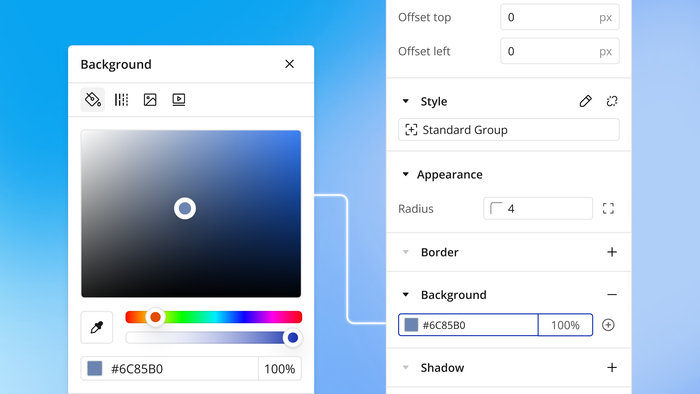If you’re thinking about building an app or launching a startup, you’ve probably heard two words tossed around more times than you can count: prototypes and MVPs. But what’s the difference — is there a difference? When you think about it, how is a “minimum viable product” any different than a prototype? And where do each of these terms fit into the larger end-to-end product development process of starting with a product idea, collecting user feedback, deciding on a set of features, and building your final product?
We’ll tell you — let’s dive in.
MVP vs prototyping
While prototypes and MVPs are often closely linked or even incorrectly used synonymously, they serve two different purposes. Both terms are used in the context of early-stage product development to help validate a product concept.
A prototype helps you gather user feedback on key features with test users to confirm that your solution solves a problem.
An MVP — also known as a minimum viable product — is a functional, in-market version of your app that helps validate product-market fit with a set of core features, usually embraced by early adopters. It isn't traditionally considered a “final product” (although we have some thoughts on that).
Both help you identify and define your core features
Whether you’re building a prototype or an MVP, you’ll want to first boil down your product concept idea into a set of core features and functionality that solves your target user’s problem.
If you’ve never done this before, it can help to think about questions like:
- What tasks or goals will a user need to complete?
- What pages, experiences, or navigation elements need to exist to complete those tasks or goals?
- What are the absolute minimum requirements users need to solve their problem?
After you’ve decided on your most essential features, you’re ready to move on to testing your concept with intended users — aka the prototyping phase.
What is a prototype?
In the traditional software and product development worlds, prototypes usually imply building out an example of your app idea to put in front of potential users to react to. You might have even heard of the phrase “rapid prototyping” to describe the process of swiftly changing your prototype designs based on initial feedback and observations. In fact, several tools exist to help teams and founders prototype their product concepts quickly and effectively.
But before we go any further, you might want to know this: We have a slightly different take on traditional prototypes and prototyping.
It’s not that prototypes aren’t helpful — conceptually, they’re a practical way to stress-test your idea and do user testing before you invest too much time, energy, or resources into your product — but they’ve historically been viewed as something you spend months developing just to throw away when you’re ready to build “the real thing” or “the final product.”
We reject the prevailing assumption that you’ll have to toss your prototype after you test it. With Bubble, there’s no need to rebuild from scratch. You can just continue fine-tuning and building on Bubble.
What are the advantages of prototyping?
One of the biggest benefits of prototyping is that it’s a fast, low-cost way to test a product idea before investing time, money, and development resources.
Because a prototype is a test version of your app, it can be as simple as a drawing you show someone for feedback. A more sophisticated prototype could be a series of clickable screens you mock up using design software. Either way, with prototypes, you can test a few features, gather feedback, and make changes quickly to validate your app idea and general usability.
By focusing on testing the most important problems to be solved, you can start to identify the features that must be included for your app to be useful — and which ones can wait until later.
What are the disadvantages of prototyping?
Sometimes it can be challenging to know when you’ve prototyped enough — in fact, many founders get stuck in a loop of collecting feedback, iterating on their prototype to reflect that feedback, collecting more feedback, and iterating more. It can be scary and unclear to know exactly when you’re “ready” to start building “the real thing.”
Plus, because prototypes aren’t truly functional, they may not reflect true market desirability or viability. If you’re not building on a platform like Bubble, you risk sinking hours upon hours building prototypes that may ultimately get tossed instead of continuously iterated and improved upon.
What is an MVP?
Think of a minimum viable product — or MVP — as a lightweight and functional early version of a product. It has only the core features and adds just enough value for your customers to want.
It’s common for founders to have different points of view on the minimum viable product approach. After all, why develop a product that’s just the bare minimum? The purpose of developing an MVP is to avoid wasting time on lengthy, expensive work that involves building “nice to have” features that aren’t really essential. MVPs are designed to get you to market faster, show traction faster, and learn from real users faster — but without all the bells and whistles. After all: It's very literally a minimum viable product.
What are the advantages of an MVP?
When you focus on minimum viable product development, you strip out unnecessary features and fluff — it forces you to get clear on the problem your product idea is solving, and the bare-bones features that are required to solve it. MVPs also help you start thinking about how you might build out and scale those core features — and even shape your business model — without getting distracted by less important functionality.
Additionally, developing an MVP gets you in market with early adopters. No longer is your product just a hypothetical prototype — it’s a functional, publicly available app. It may not be fancy, but it works and solves a problem. And, for founders looking to raise money, a minimum viable product enables you to tell investors that you already have paying users, customer feedback, and a plan for growth.
What are the disadvantages of an MVP?
Sometimes, it can be tricky to determine which features are truly valuable enough to earn a spot in the lineup. By prototyping and testing your business idea before starting MVP development, you can gain a better sense of what’s most important for users.
Another drawback of building MVPs using traditional software development methods is that developers are often focused on launching as fast as possible — but not focused on other areas like security or scalability. The result, unfortunately, is that many MVPs either pack on significant tech debt as dev teams try to stretch the limits of their initial foundation, or the MVP is scratched entirely in favor of a rebuild — both of which require time, money, and effort.
With Bubble, it’s different. Unlike the traditional development process where founders often need to start fresh, you can continuously grow from a minimum viable product to a more mature product with an optimal user experience on Bubble.
Why founders should care about MVPs, prototypes, and V1s
The early days of software development and product development can feel like swimming through alphabet soup. Knowing where to start can feel overwhelming and confusing: MVP vs prototype. Prototype vs MVP. MVP vs V1 — wait, what’s a V1?
If you’ve read our perspective on prototypes and minimum viable products, you’ll recall that “V1” stands for “version 1” — very literally, the first version of your product.
We’re all about embracing the V1. We live in a fast-paced, ever-evolving world — user feedback and iteration doesn’t stop once you officially launch. The idea of a “final product” is a myth. With Bubble, you can build, evolve, and scale from V1 to V100 all on the same platform.
For founders looking to run a lean startup and design, test, build, iterate, and scale efficiently, Bubble is the ultimate tool. With Bubble, not only can you build without knowing how to code, but you don’t need to tear up your prototypes and MVPs when you’re ready to adjust your user experience, add more features, or scale your infrastructure for future users. We don’t think you should have to start over just because your minimum viable product needs to evolve past having just enough features. Instead, we're all about helping you create a refreshing (and cost-effective) development path for wherever your product vision takes you.
Build for as long as you want on the Free plan. Only upgrade when you're ready to launch.
Join Bubble






